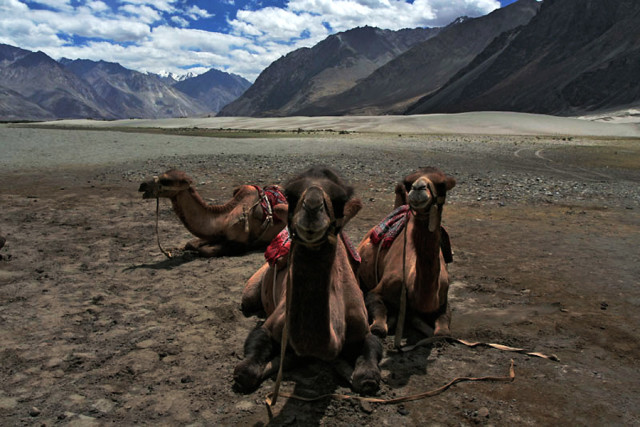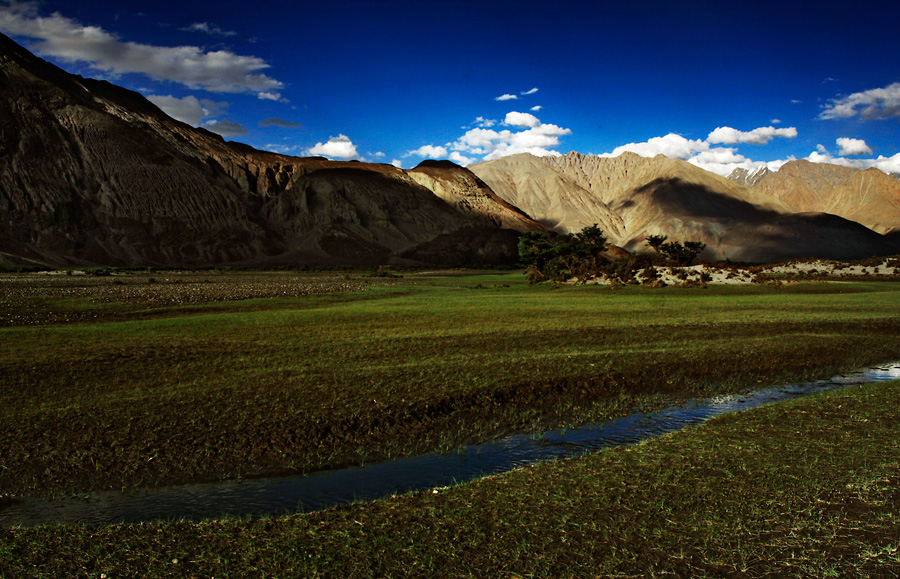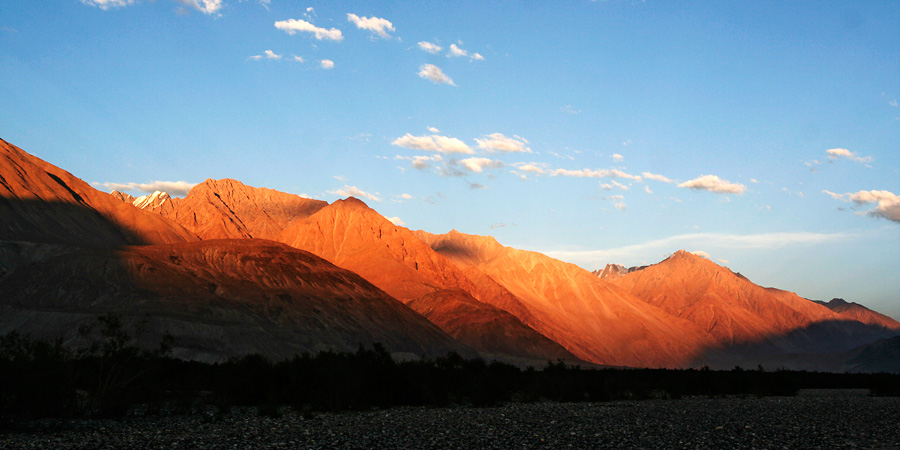Nubra Valley in Ladakh – River, Greenery and Slow Travel
I found my ideal do-nothing place in Ladakh’s Nubra Valley. It was a place for long walks in the meadows, reading books with a cup of tea in a garden chair, eating seabuckthorn fruits on the riverbed, relishing apricots straight off the tree, hiding behind the bush watching a herd of Bactrian Camel in the wild, chasing shepherds, walking along the river and watching sunsets while listening to sweet sound of the flow. The days in Nubra were filled with activity and yet I wasn’t really doing anything.
A wise man once said, “Happiness is like a butterfly which, when pursued, is always beyond our grasp, but which, if you will sit down quietly, may alight upon you.” Travelling has some semblance with this statement. If we run from place to place seeking excitement and new experiences, those pleasures always seems to be someplace other than where we are. We humans need change of place at times, but making it a mission to keep changing places probably doesn’t work. The proverbial butterfly requires that you rest.
That place to rest, I found in Hunder. It’s a tiny village in Ladakh’s Nubra Valley housing a few dozen families, and when I went there seven years ago, had only a few dozen tourists. My guest house had a room big enough to play badminton, and outside in the garden, you could actually play football. The garden, however, was put to a more idyllic pursuit. With a book in one hand and a cup of tea in the other, I could sit under the apricot trees and while away the entire day, sometime shifting into the sun and sometimes returning to shade. And when I had enough of the book, there were other hedonistic pursuits that are hallmark of an aimless traveller.
Long, drifting walks was one of them.
Hunder is located at the edge of a valley a few kilometers wide. It is a curious mix of cultivated land, jungles of seabuckthorn shrub, white sand dunes created by flow of the river and a wide open stretch where Shayok River flows freely. All this is bounded between mountains that climb steeply in two directions. Thanks to the flat terrain of the river bed, walking here is easy and effortless. I often ambled for hours during the day without a purpose or destination, sometimes taking the grassland, sometimes treading the sand, often seeking the edge of the river’s flow and occasionally crossing smaller water channels.
I would pause frequently to pluck mildly sour seabuckthorn from the wild bushes or apricots from trees heavy with fruits. Once, lost faraway from the village, we ran into a group of Bactrian camel (more about them later) that had long since gone wild enough to be uncomfortable with human presence. They were startled to see us and contemplated fleeing, but decided to stay on and keep a careful eye on us as they chewed happily on seabuckthorn leaves. We kept away from them, retreating and maintaining a distance safe enough to make them feel comfortable, yet near enough to see the herd well.
Another time, I followed a herd of sheep heading home after the day’s grazing. They kicked up dust against the evening sun and occasionally moved helter-skelter, making the shepherd work hard to push them bank into the line.
One evening, I walked into a potato field at the edge of the river, where the farmer’s family was at work plucking the weeds. It began with the usual conversations – ‘where are you from?’, ‘where are you staying here?’ and ended with sharing a few cups of tea.
The evenings were usually dedicated to sitting by the river and watching the flow of water, often being amazed at the continuous flow coming from afar and going afar, always in a terrible hurry. Much after sunset, the faint glow in the sky would guide us back to the guesthouse. Everyday was spent in the same manner, and every evening I would think that the day couldn’t have been spent better.
Nubra Valley – A short guide
Nubra is located about 100km (5 hours) away from Leh in Ladakh. The road to Nubra goes through mighty Khardungla, the 18,000 feet pass believed to be one of the highest passes in the world with a motor road. Hunder and Diskit are two villages where most travellers facilities are available.
A few kilometers upstream from Diskit is Tegar, the place of confluence of Nubra and Shayok Rivers. From here, it is a wide open valley filled with shrub jungles or grassy meadows. Shayok River flows somewhere in the center of the valley.
One of the popular attractions of the valley are its white sand dunes, probably created ages ago when the river dominated the features of the valley.
 Located close to Karakoram Pass, Nubra served as a feeder route to the famous silk route a century ago until the modern political boundaries redefined the trading patterns. During these times, a small population of tamed Bactrian camel was used to carry goods along the trade routes. With the creation of modern nations that shut the boundaries, camel population in Nubra went astray and a large number of them became feral. It’s now probably appropriate to call them wild, after they have lived for generations of roaming free in Nubra’s shrub jungles.
Located close to Karakoram Pass, Nubra served as a feeder route to the famous silk route a century ago until the modern political boundaries redefined the trading patterns. During these times, a small population of tamed Bactrian camel was used to carry goods along the trade routes. With the creation of modern nations that shut the boundaries, camel population in Nubra went astray and a large number of them became feral. It’s now probably appropriate to call them wild, after they have lived for generations of roaming free in Nubra’s shrub jungles.
A few of these camel have been tamed again by entrepreneurial locals who offer rides to tourists.
Until five years ago, Hunder was the last resort for travellers visiting Nubra. The government of India opened this route further towards the border with Pakistan a few years ago, now permitting travel up to Turtuk Village.
Also see: everything you need to know about travel in Ladakh



